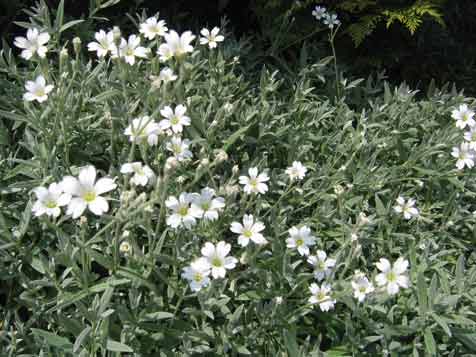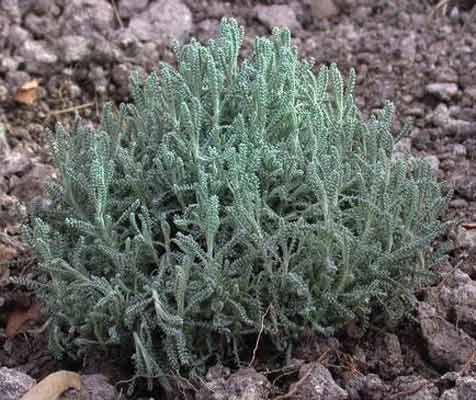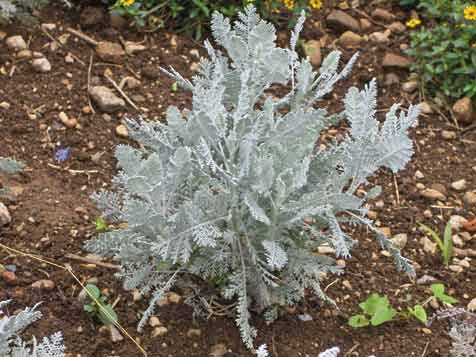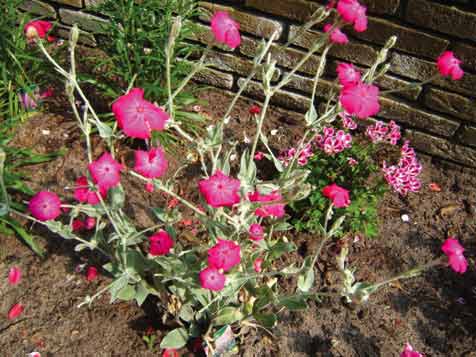Silver Foliage Turns a Humdrum Bed into a Star
Shimmering Leaves

Plant foliage comes in many shades. Green is the one that springs to mind first, of course, but gardeners and garden lovers alike know that there are many other hues available from red to purple (and nearly black), yellow, orange, nearly blue, and almost white. Another color, one that can be useful in a number of ways, is silver.
Silver-foliaged plants seem to shimmer and shine. Most of the effect is due to tiny hairs covering the surface of leaves and stems that reflect the light back to our eyes. This essentially masks the green of the chlorophyll that gives plants their usual color. It’s still there in these plants, but we can’t see it because of all the glitz. Many of these plants have utilized this strategy to survive in areas of high light (and its resultant heat) intensity. For gardeners, that means that they are useful in low-water use plantings (which we all agree by now that we should be striving for, right?).

Using silver foliage in the garden can make a humdrum bed into a star. Not only can these plants shine a light into a dark corner, they become a great foil for other colors. Since silver is such a cool hue, it is wonderfully effective when paired with hotter colors. Sunrose (Helianthemum nummularium) does this one naturally. There are species and varieties in every hue of yellow, orange, pink, and red flowers that are born on silvery plants that top out at six to eight inches, but spread to nearly three feet across. Plant it in front of the border. Lychnis coronaria is a perennial that forms short clumps of silvery leaves about six inches in height. Its flowers are pink, but they are a very hot version. In spring, tall flower stalks arise to attract the attention of humans and insects. Santolina (Santolina chamaecyparissus), also known as lavender cotton, is a good ground cover or edging plant that sports small, rounded yellow flower heads. There are two different species of sunflower relatives that are known by the common name of dusty miller. Only one will also be topped with yellow daisy-like flowers and some gardeners clip them off and focus on the foliage itself, but they do provide a handsome pairing if you plant them with that in mind. While they share a common name, these plants are quite different in form. Perennial Senecio cineraria has bolder foliage with large divided leaves and forms a rounded shrub to two to three feet topped by golden yellow flowers.

Much more delicate is Tanacetum ptarmiciflorum, with almost fern-like leaves and its small, white flowers that add to the silvery effect. In cooler areas, it is an annual and most gardeners find it easier to treat it as one wherever they grow it. Several other white-on-silver combinations can be found. Bush morning glory, Convolvulus cneorum, is a handsome shrub from two to four feet in diameter that produces small, white, funnel-shaped flowers nearly all year long. Snow-in-summer, Cerastium tomentosum, is a very drought-tolerant, silver groundcover. In summer it is also clothed in small, white flowers to cool down the heat.

Cool shades of blue and purple also pair up with silvery foliage naturally and can provide inspiration for other ways to pair these pale plants in your own landscape. Purple sage, Salvia leucophylla, is a well-known favorite and nearly always in bloom. Russian sage, Perovskia species and hybrids, are tough, clumping perennials that are topped with bluish-purple flower spikes in summer. If you just want silvery foliage with no distracting flowers, there are a couple of choices whose flowers are brief and/or inconspicuous. The licorice plant, Helichrysum petiolare, has rangy stems covered with small, rounded leaves, and its flowers never take the limelight. (By the way, there is a cultivar called ‘Limelight’ that has bright, chartreuse foliage.) A close relation to well-known coleus, Plectranthus argentatus, is as silvery as they come. While it does bloom, the flower spikes are narrow, don’t last long, and can be nipped in the bud just as you would a coleus plant. It looks like a coleus, can be pinched and pruned like a coleus, but, as an Australian native, is way more drought tolerant.
Whether you use a silvery plant to cool the heat of bright colors or create the coolest garden by filling it with shades of blue and silver, these brilliant and gleaming subjects can and should find a place in your planting palette.



